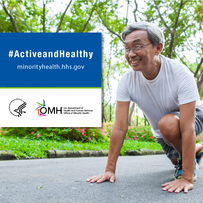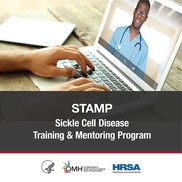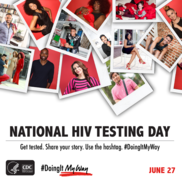 June is Men's Health Month, a time to encourage men to take control of their health, and for families to teach young boys healthy habits throughout childhood. According to the Centers for Disease Control and Prevention (CDC), men in the United States, on average, die five years earlier than women and die at higher rates from the three leading causes of death, heart disease, cancer and unintentional injuries. To help raise awareness, the HHS Office of Minority Health (OMH) will focus on promoting the Five Plays for Men's Health to encourage men and their families to practice and implement healthy decisions and habits. The plays will highlight the importance of heart health, daily exercise, regular check-ups, smoking dangers and mental health. Men's Health Week (June 15-21) is observed the week before Father's Day and serves to promote early detection and treatment of disease among men and boys. Make sure to wear something blue to celebrate Wear Blue Day on June 19 and encourage others to join you in showing support for men's health. Visit our Men's Health Month webpage for the Five Plays for Men's Health, downloadable materials and access to men's health resources. |  OMH continues to motivate Americans to stay Active & Healthy in and around their homes and advance mental and emotional wellness during these uncertain times. Through simple and creative steps, everyone can keep their minds and bodies active while adhering to the social distancing guidelines to stop the spread of COVID-19. According to the Office of Disease Prevention and Health Promotion, physical activity can help boost your mood, sharpen your focus, reduce your stress, and improve your sleep. The National Institutes of Health have also developed six strategies for improving your emotional health in order to help your emotional wellness. Encourage others to take active and healthy steps towards better health by sharing resources, downloading our graphics, and using the hashtags #ActiveandHealthy and #EmotionalWellness. |  The Sickle Cell Disease (SCD) Training and Mentoring Program (STAMP) is a collaboration between OMH, the Health Resources and Services Administration (HRSA) Maternal and Child Health Bureau, and the HRSA Bureau of Primary Health Care. STAMP is a free telehealth series taught by hematologists for primary care providers. The program trains primary care providers on the basics of sickle cell disease care such as pain management, hydroxyurea, and preventive services. Trainings this month include:
- Wednesday, June 10, 2020 ǀ 12 PM ET: Contraceptives in SCD
- Tuesday, June 23, 2020 ǀ 5 PM ET: Telemedicine in SCD
Visit our sickle cell disease site to register and learn more about upcoming trainings.
|  June 19 is World Sickle Cell Day and OMH joins in sharing resources and information about sickle cell disease. According to the CDC, in someone living with sickle cell disease, the red blood cells become hard and sticky and look like a C-shaped farm tool called a "sickle." This shape can cause pain and other serious problems such as infection, acute chest syndrome and stroke. Sickle cell disease is estimated to: - Affect approximately 100,000 Americans.
- Occur among about 1 out of every 365 Black or African American births.
- Occur among about 1 out of every 16,300 Hispanic American births.
- Affect more than 300,000 babies every year in Sub-Saharan Africa.
To address the needs of those living with the disease worldwide, HHS joined the global community last year in a roundtable discussion on how to improve the identification and care of sickle cell disease in Africa. Furthermore, HHS is committed to extending the lives of Americans with sickle cell disease by 10 years, within 10 years. People with sickle cell disease can live full lives and enjoy most of the activities that other people do. OMH Sickle Cell Stories give individuals who are living their healthiest lives with sickle cell, the chance to share their testimonies of what it's like to live with the disease and how it impacts everyday life. Visit the OMH sickle cell disease website for resources, webinars, testimonies, downloadable graphics and more. |  According to HIV.gov, National HIV Testing Day was first observed on June 27, 1995. Nearly 25 years later, the observance continues to urge people to get tested for HIV in order to know their status. About one in seven people living with HIV don't know it and an estimated 38,000 new HIV infections still occur in the United States each year. The federal response to the epidemic has led to various initiatives and programs including:
Talk with your loved ones about getting tested and share resources to help spread HIV awareness.
|  In observance of Men's Health Month, the Knowledge Center is highlighting its collection of recent publications related to the health of minority men. To access some recent publications on men's health for minority groups, click here.
| |

No comments:
Post a Comment